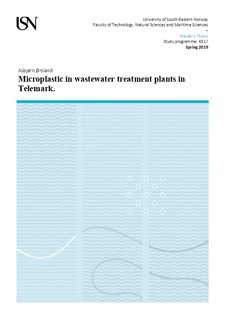| dc.contributor.author | Ørsland, Asbjørn | |
| dc.date.accessioned | 2019-08-26T12:17:52Z | |
| dc.date.available | 2019-08-26T12:17:52Z | |
| dc.date.issued | 2019 | |
| dc.identifier.uri | http://hdl.handle.net/11250/2611028 | |
| dc.description.abstract | Microplastics (defined as 5 mm to 1 μm in diameter) has been observed in zooplankton fish and human beings in various studies. The amount of microplastic is an increasing concern worldwide, and one of the sources that contributes to microplastic in the environment is wastewater treatment plants. The aim of this study was to analyse the presence of microplastics in inlet, effluent wastewater and sludge, and to develop an appropriate analysing procedure based on a thorough review of past literature. This study was executed in cooperation with SWECO located at Seljord, where a total of 8 wastewater treatment plants were chosen. Four of these plants carry out biological treatment and these plants were investigated in this thesis.
Sampling was done in the period from June to October 2018. The samples were extracted during the monthly sampling for chemical analysis. The sampling was carried out by staff at the wastewater treatment plants where 38 wastewater samples and 19 sludge samples were taken during this period. Wastewater and sludge sample was sterilised with 70% ethanol, then the wastewater was vacuum filtrated with Whatman GF/C filters. After the sterilisation the sludge was dried before adding Fenton’s reagent followed by a flotation with filtered tap water and vacuum filtration. GF/C filters from both samples was then stored in aluminium coated petri dishes after the vacuum filtration and visual observed with digital stereo microscope (Karl Zeiss Discovery V20). Microplastics was detected in all samples in this study with an average of 8544 particles kg¯¹ dry weight (d.w.) for sludge and 13644 microplastic particles/L for inlet and 6255 microplastic particles/L outlet wastewater samples. There seems not to be any relation between income of wastewater (m3/d) and the amount of microplastic observed within the samples. Particles from wastewater consisted of fibres (11%), fragments (59%) and beads (30%) and most of the particles were white/transparent and blue. Particles from sludge consisted of fibres/filaments (72%), fragments (23%) and beads (5%), where most observed particles where black fibres. For further research a procedure that includes removal of cellulose would make it easier for visual detection of MP in the samples. | nb_NO |
| dc.language.iso | eng | nb_NO |
| dc.publisher | University of South-Eastern Norway | nb_NO |
| dc.subject | microplastic | nb_NO |
| dc.subject | microplastic method | nb_NO |
| dc.subject | microplastic in wastewater and sludge | nb_NO |
| dc.title | Microplastic in wastewater treatment plants in Telemark | nb_NO |
| dc.type | Master thesis | nb_NO |
| dc.description.version | publishedVersion | nb_NO |
| dc.rights.holder | Copyright The Author | nb_NO |
| dc.subject.nsi | VDP::Mathematics and natural science: 400::Zoology and botany: 480::Limnology: 498 | nb_NO |
| dc.subject.nsi | VDP::Mathematics and natural science: 400::Chemistry: 440::Environmental chemistry, natural environmental chemistry: 446 | nb_NO |
